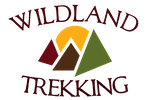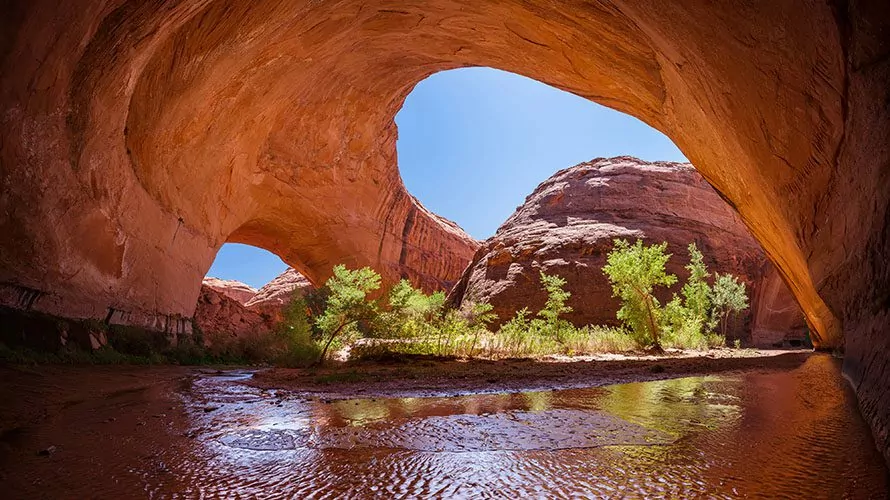
Coyote Gulch
St. George, UT
Description
This is our most popular hike in Utah and deservedly so. We give you a glimpse of what Glen Canyon was like before being flooded by Lake Powell, and as such this is a true treasure. Highlights include beautifully sculpted streambeds, intimate cascades and waterfalls, deep overhangs and alcoves, and numerous natural bridges and arches. This hike has incredible diversity, as we finish with an exciting ascent out of the canyon and across a stretch of signature Utah slickrock.
Our backpacking trip begins in St. George, Utah where we get an early start and drive to the remote trailhead. From the trailhead we’ll work our way down the Coyote Gulch drainage. For the next four days this dramatic canyon takes us through some of the most beautiful country in the United States. It culminates on Days 3 and 4 with an amazing arch, natural bridge, pictographs, waterfalls, fantastic side canyon exploration, and a memorable ascent out of the canyon. Our guests tend to fall in love with this route but we want to forewarn you, the power of this place awakens strong emotion. People often feel compelled to return again and again throughout their lifetime in search of more “good times!”
Watch a video of Wildland guests describing Coyote Gulch while on the trip!
Need to Know: Waste Regulation & Width Requirement
Waste Regulation – The public agencies that oversee this region require that everyone doing Coyote Gulch pack out all solid waste, including human waste. We provide resources and training to make this manageable and efficient. However, if you’d rather embark on a trip in this region where that isn’t required, we recommending checking out the 4-day Boulder Mail Trail.
Width/Climbing Requirement – You must be able to fit through an 18 inch “crack in the wall” on the final day of this tour. To test whether you can fit through, we recommend opening up a door to 18 inches, turning sideways and shuffling through the opening. You must also be able to safely navigate a tight corridor that involves a climb up and over a rock shelf and maneuvering your body weight in this condensed environment. The terrain in this sandstone crack can be sandy, steep, rocky, uneven and/or muddy. Hikers must be able to remain balanced in this terrain with or without support. There is not an alternative exit for this final day of the tour. If you’re unable to fit through an 18-inch crack or uncomfortable with the terrain, we recommend looking at the Boulder Mail Trail as a great alternative Utah backpacking trip.
| Trip Type: Guided Backpacking Trip |
Difficulty Level:
|
|
Solitude Level:
|
Group Size: 1-6 Guests |
| Trip Length: 4 Days | Distance: 16MI / 26KM |
|
Hiking Distances: 2-6 mi |
Backpack Weight: 30-35 lbs |
|
Terrain: Significantly Rugged |
Max Daily Elev. ↑↓: 800 ft |
|
Heights Exposure: Light |
DIFFICULTY LEVEL 3
Scale of 1-5. 1 is least difficult; 5 is most difficult
Most days on this trip are relatively flat with little elevation gain, but the final day involves a 800 foot climb over 2.5 miles and squeezing through the 18 inch wide “Crack-in-the-Wall”. You will need to fit through the 18 inch crack, there is no alternative route.
Please Note: Terrain, Elevation Gain and Heights Exposure ratings reflect the section or day of the trip with the maximum difficulty of each. Much of the trip is at easier levels. See the trip itinerary for more detailed information. Backpack Weight ratings are estimates that account for Wildland-provided gear, guest clothing, personal items and a share of group food. By packing light it’s often possible to stay on the lower end of the weight range. Pack weights also decrease during the trip.
PHYSICAL DEMANDS OF THIS TRIP
- Hiking uphill or downhill with a 30-35 lb backpack for 5-7 hours
- Maintaining balance and footing on variable terrain
- You must be able to fit through an 18 inch “crack in the wall” on the final day of this tour. To test whether you can fit through, we recommend opening up a door to 18 inches, turning sideways and shuffling through the opening. You must also be able to safely navigate a tight corridor that involves a climb up and over a rock shelf and maneuvering your body weight in this condensed environment. The terrain in this sandstone crack can be sandy, steep, rocky, uneven and/or muddy. Hikers must be able to remain balanced in this terrain with or without support. There is not an alternative exit for this final day of the tour.
SOLITUDE LEVEL 3
1 least solitude, 5 most solitude
We rate this Utah backpacking trip a Level 3 on solitude. You can expect to see a handful of other groups per day. At certain times of year, such as Spring Break, you can expect to see more people.
Learn More about our Rating SystemWhat’s Included
- Top-of-the-line tent, backcountry sleeping pad and multi-day backpack
- High quality, synthetic sleeping bag (professionally laundered after every use) – or bring your own.
- Use of trekking poles
- Use of Neoprene socks
- All meals are included from breakfast the first day through lunch on the last day
- A professional, knowledgeable, certified Utah hiking guide
- Roundtrip transportation from your hotel in St. George, Utah to the trailhead and back
- National park entrance fees
- Emergency equipment including a company-issued first-aid kit and satellite communication device
WHAT’S NOT INCLUDED
Day 1
- Shuttle to the trailhead: 5-hour drive from St. George
- Mileage: 5 miles
- Elevation Loss: 300 feet
This Utah backpacking trip begins at a remote trailhead at the “headwaters” of Utah’s Coyote Gulch. From the trailhead we hike a short distance before entering an open and dry wash, the upper section of Coyote Gulch. The day’s hike continues downstream and gradually the wash begins to resemble a canyon as short walls of Navajo Sandstone begin to appear on either side of the wash and we come to several pour-offs and short waterfalls. Just as the canyon begins deepening we’ll find ourselves in a beautiful cottonwood grove and our camp for the evening.
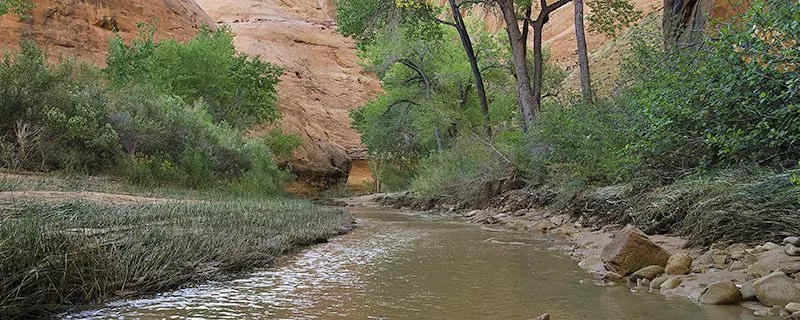
Day 2
- Mileage: 6 miles plus optional day hikes
- Elevation Loss: 200 feet
Continuing our hike downstream through stands of cottonwood and willows, the gulch deepens and narrows and encloses us in a towering corridor of sandstone. The creek is flowing continuously now and there are numerous crossings. As we progress, the day’s changing light plays on the canyon’s walls in a brilliant show of reds, yellows and browns. These imposing walls are the backdrop for features closer at hand: beautifully sculpted streambeds and intimate little cascades and waterfalls.
After a few miles of hiking in an especially sinuous and narrow part of the gulch, we’ll hike by an amazing backcountry arch. Another half mile hike downstream brings us to a natural bridge. We’ll walk directly underneath this unbelievable feature and make camp in the vicinity.
After dinner we’ll explore the truly amazing Native American ruins nearby. Bands of Fremont people, a pre-Columbian culture that lived contemporaneously with the Anasazi through 1300 AD, once called Coyote Gulch their home. They farmed plots of land and made their dwellings beneath the canyon’s walls. Our second night’s campsite allows us to see a fine pictograph panel at the base of the Navajo Sandstone, a small ruin littered with artifacts, and a Fremont Indian dwelling.
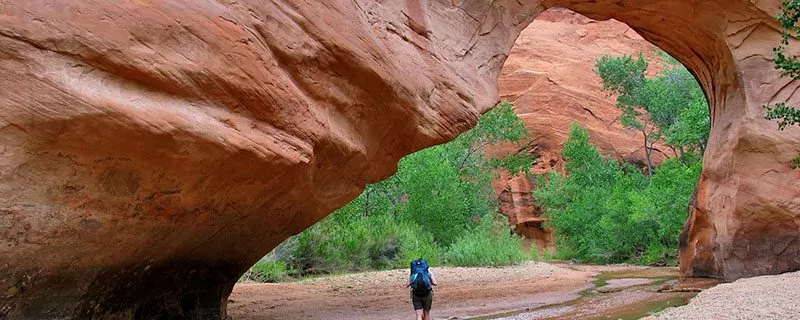
Day 3
- Mileage: 2.5 miles and 2 miles optional day hiking
- Elevation Gain: 600 feet
- Elevation Loss: 600 feet
A casual morning and delicious breakfast will precede more beautiful hiking downstream. Several miles from camp we’ll hike beneath yet another wonderful rock feature, a spectacular arch several hundred feet above the canyon floor. The character of the canyon changes again as we progress, becoming wider with steep vegetated hillsides beginning to appear beneath the canyon’s walls. Larger pour-offs accompany a higher stream volume and sandstone terraces begin to appear above deep overhangs where the stream flows.
After traversing a sandstone slab we’ll follow the terraces for easier hiking and ascend 200 feet above the stream to our dramatic campsite overlooking the confluence of the Escalante River and Coyote Gulch. Camping here under a steep cliff wall, looking directly through Stevens Arch. Time permitting, we’ll have the opportunity to attempt to day hike to the confluence of the Escalante River or to a remote and spectacular side canyon. Those so inclined are more than welcome to relax in camp and enjoy the breathtaking views of the stunning Escalante Canyon rather than day hike.
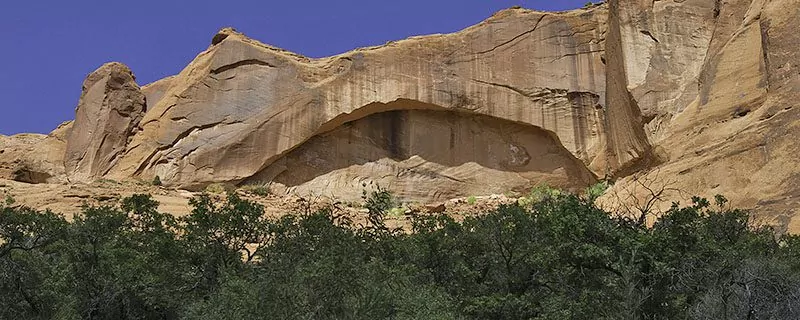
Day 4
- Mileage: 2.5 miles
- Elevation Gain: 800 feet
- Shuttle to St. George: 5-hour drive
Following breakfast we’ll break camp and begin our ascend up a long sandy slope. It is a strenuous hike in soft sand to the “crack in the wall,” a narrow crevice we’ll use to escape the canyon’s upper-most cliff wall. From the top we’ll have a brilliant view of the Escalante River and the surrounding canyon system. After the guide hauls everyone’s backpack over the rim with a rope we’ll hike two miles across the desert to our ending trailhead and our vehicle. Refreshing drinks and a comfy suburban signify the end of our Utah backpacking trip and will get us safely back to St. George.
Please Note: participants must be able to fit through an 18 inch “crack in the wall” on the final day of this tour. To test whether you can fit through, we recommend opening up a door to 18 inches, turning sideways and shuffling through the opening. If you’re unable to, we recommend looking at the Boulder Mail Trail as a great alternative Utah backpacking trip.
Please Note: We always do everything in our power to follow the set itinerary, however it can change occasionally based on temporary access restrictions, weather, lodging/campground availability, guest ability/injury, natural events like fires and flooding, and other potential causes. Normal terms and conditions apply to trips with itinerary changes.
PACKING LISTS

IMPORTANCE OF BEING PREPARED
Your safety and enjoyment will depend on your level of preparedness. It is your responsibility to arrive with the items listed below. Our Gear Guide is a resource to find more information about these items and links to online options. If you have additional questions about what to pack, please ask your guide during the pre-trip contact (~10 days prior to the trip start date) or call our Adventure Consultants 7 days a week at 928-223-HIKE (4453).
Packing List Video
For more guidance on the packing list, we recommend watching our Wildland Packing List Video. A senior Wildland guide and outdoor retail expert walks us through each item with examples and insights. Click here to see the video.
STANDARD CLOTHING CHECKLIST
The following items are required for your trip unless otherwise noted. When packing, think layered clothing systems that work together and can be easily added or removed.
(GG) = Gear Guide: see for more info and links to product options
- Hiking Boots/Shoes – Please read the “Footwear Requirements” section below
- Secondary Footwear – supportive, protective, lightweight camp shoes (Camp Shoes GG)
- Hiking Socks – one pair for every day or two days of your trip, plus an extra pair to sleep in. Hiking specific padded socks, no cotton please! (Socks GG)
(Note: wearing thin liner socks under your hiking socks can help prevent blisters) - Sun Hat – wide brimmed hat or baseball cap/bandana combo (Sun Hats GG)
- Cotton T-shirts – 2 short and/or long sleeve cotton t-shirts.
(Note: April-October only. Cotton retains moisture and helps to cool the body down in hot, arid desert environments. Cotton shirts are critical garments in terms of safety and comfort in the hotter months.) - Hiking Shirt – 1 non-cotton, breathable long sleeve shirt (Shirts GG – Sun Hoodies GG)
(Note: long sleeve shirts provide better sun protection) - Warm Top – mid-weight sweater or pullover of wicking material – merino wool, fleece or polypropylene (Mid Layers GG)
- Hiking Pants & Shorts – nylon pants AND shorts, zip-offs or leggings (Pants GG – Shorts GG)
- Rain Gear – waterproof jacket, breathable fabric such as Gore-Tex® or coated nylon (Rain Jackets GG)
ADDITIONAL CLOTHING (OCTOBER TO APRIL)
- Additional Hiking Shirt – 1 additional non-cotton, breathable long sleeve shirt (Shirts GG – Sun Hoodies GG)
- Warm Hat & Gloves – lightweight beanie and light-to-mid weight fleece or wool gloves (GG)
- Mid Layer Insulating Jacket – down-fill or synthetic-fill insulated “puffy” jacket or warm, heavy weight fleece jacket (Mid Layers GG)
- Base Layer/Long Underwear – 1 pair of wicking tops and bottoms that are lightweight to midweight, synthetic wicking materials such as polyester, polypropylene, merino wool…etc. (Base Layers GG)
- Rain Pants – waterproof pants, breathable fabric such as Gore-Tex® or coated nylon. Look for side zippers that will allow you to pull them over your boots. (Rain Pants GG)
Important Note: Please, no cotton hiking clothes with the exception of the “Cotton T-shirts” section above (which are important!) Feel free to call us if you have any questions or you can reference our Gear Guide.
GEAR CHECKLIST
- Hydration System – 3+ liters capacity, either water bottles or bladder/hose system and an additional water bottle (Hydration Bladders GG)
(Note: We recommend always having a bottle with 1 liter of capacity as a back-up in case of a hydration system failure and to use while in camp) - Headlamp – preferably with an L.E.D. bulb that works with AA or AAA batteries (Headlamps GG)
(Note: always test your headlamp before trips, travel/pack without batteries in device, and for longer trips (4+ days) consider a spare bulb and 1 set of spare batteries) - Sunglasses, Sunscreen, Lip Balm
- 2 Bandanas
- Contact Lenses and Glasses – if you wear contact lenses, please also bring a pair of glasses – your contacts are likely to become dirty and may be difficult to clean
- Prescription Medication – please inform your trip leader of any medications you are taking
- 1-2 Face Masks (Recommended but Optional)
- Toiletries – small amounts, travel sizes and/or just what you need for the trip (important that they are small!)
- Money – for any shopping you would like to do and for consideration of tipping your guide
(Note: tipping is optional but appreciated, industry recommendation is 10-20% of your trip cost based upon the quality of your experience)
OPTIONAL ITEMS
- Personal Sleeping Bag – please see information about bringing your own below (Sleeping Bags GG)
- Personal Trekking Poles – as a Wildland guest, you can enjoy a 20% discount off Leki trekking poles (reservation number required.) Click here for discount. Trekking poles are provided for guests who do not bring their own. (Trekking Poles GG)
- Swimsuit – only if swimming is an option on your trip, some guests prefer to swim in quick drying hiking clothes, sports bra, etc…
- Camp Pillow – lightweight, compressible and packable
(Note: many guests use their extra clothing in a stuff sack with a bandana as a pillowcase, and it works well) - Stuff Sacks – various sizes for better organization of clothing & gear, and/or to help create a camp pillow, etc.
(Note: A lightweight waterproof stuff sack can be extremely useful in wet conditions) - Support Braces – consider bringing any joint braces that may be currently needed or from past injuries (i.e. knee, ankle, elbow, etc…)
- Camp Reading Material – lightweight paperback book, magazine or small notebook/pen for journaling
- Cell Phone or Camera
- Spare Batteries – for camera, headlamp or other electronics
- Solar Charger or Charging Bank – small, lightweight devices to recharge electronics
- Vitamins & Supplements
- Quick Dry Towel – lightweight, compressible and packable – bandanas also work
FOOTWEAR REQUIREMENTS
This trip includes hiking on the canyon floor of a world-class slot canyon. There is no sanctioned trail as the trail is the canyon floor. This canyon has perennial water that flows through the route that we will be walking in. You will be walking in ankle to thigh deep water everyday of the trip. We will be in at least ankle-deep water for the most part of each day. There will be several sections along the route where the water could be deeper, depending on the time of year and recent precipitation. There will also be sections of hard packed and softer sand where you are not walking directly in the steam. It is important to be prepared with the proper footwear to ensure your safety and enjoyment.
Your shoes should be lightweight and breathable, so water is able to escape your shoes once it gets inside. Waterproof, Gore-Tex shoes are not a good option on this hike because once they get wet, they have a tendency to stay wet. We highly recommend a lightweight, non-waterproof trail runner for this trip because you can set them out to dry at camp and then put on dry shoes in the morning. We provide neoprene socks to wear in place of socks to keep your feet warm in cooler weather. If the weather is warmer and we will not wear neoprene socks, we recommend merino wool socks for inside your trail runners. Merino wool socks are a great alternative to neoprene socks when hiking in water as the fibers are soft, breathable and moisture-wicking as well as insulating when wet.
- Lightweight
- Quick drying
- Toe protection
- Ankle support
- Sturdy sole for all day hiking
BRINGING YOUR OWN SLEEPING BAG
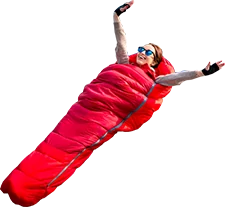 Some guests choose to bring their own sleeping bag. We supply high quality, synthetic fill bags that are professionally laundered after every trip. Synthetic fill is non-allergenic, insulates when damp and stands up well to repeated washings, but is heavier and bulkier than down. If you’re able to bring your own down sleeping bag, there are multiple benefits. If not, we’ve got you covered!
Some guests choose to bring their own sleeping bag. We supply high quality, synthetic fill bags that are professionally laundered after every trip. Synthetic fill is non-allergenic, insulates when damp and stands up well to repeated washings, but is heavier and bulkier than down. If you’re able to bring your own down sleeping bag, there are multiple benefits. If not, we’ve got you covered!
Thinking about purchasing a sleeping bag for your trip? Take a look at our Best Sleeping Bags Guide for our top suggestions.
SLEEPING BAG TEMPERATURE RATING NEEDED FOR THIS TRIP:
– Mar: 0-15°F
– Apr: 15-30°F
– May – Sep: 30-45°F
– Oct – Nov: 15-30°F
TRAVEL, TRANSPORTATION, MEETING & LODGING

MEETING TIME & PLACE
You will rendezvous with the guide and group in St. George, Utah for an orientation meeting at 5:00 PM the evening before the trip begins. Alternatively, you may choose to forfeit the pre-trip meeting and meet us in the town of Escalante, UT on the first morning of our trip. This can be more convenient if you are traveling overland from points North or East, but not recommended if you are a novice backpacker.
Your guide will be in contact approximately 2 weeks before your trip starts to specify the orientation location. The guide will then pick you up at your hotel the next morning for transport to the trailhead.
TRIP CONCLUSION
This trip will conclude at approximately 7:00 PM on the last day.
ARRIVAL & DEPARTURE DATES
Travel to and from the trip starting point is not included in the cost of our trips. Please plan on arriving in time for the orientation meeting the day before the trip leaves and departing the day after getting back from the field.
GATEWAY CITIES:
Las Vegas, Nevada or St. George, Utah
All Utah trips begin and end from St. George, Utah. St. George has a small airport served by Delta Connection and United Express. From the St. George Airport one can take a taxi into town or some hotels offer a complimentary airport shuttle. One can also fly into Las Vegas and rent a car or take a shuttle to St. George. This is often your cheapest option. It is a 2-hour drive from Las Vegas to St. George on good roads.
SHUTTLE FROM LAS VEGAS TO ST. GEORGE
St. George Shuttle (run daily vans from Las Vegas to St. George): 435-656-9040
TRANSPORTATION TO & FROM THE TRAILHEAD
We will pick you up at your hotel in St. George on the morning of the first day of the trip, and provide transportation back to your hotel in St. George on the final day.
STORAGE OF PERSONAL ITEMS & VEHICLES
We recommend checking with your pre- and post-trip hotel(s) to inquire about luggage storage. Most of the time hotels are happy to accommodate. You’re also welcome to leave your luggage in the company vehicle; however, we don’t take responsibility for its safety.
PRE & POST-TRIP ON REQUEST LODGING
We secure limited amounts of pre and post trip lodging in St. George, Utah as an optional add-on for guests of this trip. This lodging is on request, and is available on a first come, first serve basis. If interested, please reach out directly to our team to check availability.
PRE & POST-TRIP RECOMMENDED LODGING
Lodging options in St. George are numerous. We recommend the Best Western Coral Hills (details below) based on convenience, price and overall experience.
Best Western Coral Hills (location of On Request Lodging, downtown hotel with indoor/outdoor pools, in-room mini-fridge/microwave, coin-operated laundry on-site and ample parking)
Website / 435-673-4844
TRIP INSURANCE
We strongly recommend purchasing trip insurance. We designed our terms and conditions with trip insurance in mind. When you register for a trip, your spot is no longer available to other guests. Therefore, if you discover inside of 30 days (prior to your trip departure date) that you are unable to travel, no refund is available. With trip insurance, not only is your payment to Wildland covered, but your flights, hotels and other travel costs can also be insured.
Read more about our trip insurance recommendations.
CHECK THE WEATHER FORECAST FOR YOUR TRIP
We recommend using NOAA’s website (www.weather.gov) for the most accurate 5-day weather forecasts. Click here to check the 5-day forecast for this trip.

PACK WEIGHT AND CONTENTS
You will be hiking with a multi-day backpack that we provide. You’re also welcome to bring your own. The contents will be what you need for the trip – tent, sleeping bag, sleeping pad, clothing, rain gear, water, personal items, and a share of group food/gear.
ESTIMATED PACK WEIGHT: 30-35 POUNDS
ESSENTIAL ELIGIBILITY CRITERIA
Essential Eligibility Criteria (“EEC”) have been specifically identified to help you understand the skills and abilities necessary to participate on each Wildland trip, and they apply uniformly to all potential trip participants, irrespective of the presence or absence of any disability.
Once you identify a trip in which you may be interested, please carefully review the EEC and itinerary details. If after reviewing the EEC that apply to your desired trip, you determine you need an accommodation in order to meet the EEC, please contact us prior to registering to discuss your requested accommodation.
The EEC exist for your own safety and the safety and enjoyment of all participants. If you are unable to meet the EEC for the trip, with or without an accommodation, you are not eligible for that trip. If you register and arrive for a trip for which you do not meet the EEC, you will be disqualified from participation on the trip and will be dismissed or evacuated from the trip without a refund.
TRAINING TIPS

The better shape you’re in the more fun you’ll have! We recommend very strongly that you train for your trip.
TRAINING BY HIKING
If you have access to hiking trails in hilly or mountainous terrain, this is the ideal way to train. If not, we recommend using the Stairmaster machine (with rotating stairs like an escalator) or actually training on stairs. Nothing prepares you for a trip better than the activity itself!
Train at least 3 days a week. Start with short hikes or workouts (1-hour in length) with a light daypack. From week to week build the length and intensity of your hikes/workouts and gradually increase your pack weight until you’re comfortably able to hike 6-8 hours a day carrying the weight you’ll have on your trip. It’s best to begin your training regimen at least 12 weeks prior to your trip. Also be sure to use the boots you’ll have on your trip to break them in.
Following is how a program may look:
| First Week | Work Up To |
| Tuesday: 1-hour hike/workout with daypack Thursday: 1-hour hike/workout with daypack Sunday: 2-hour hike/workout with daypack |
Monday: 2-3 hour hike/workout with daypack Wednesday: 2-3 hour hike/workout with daypack Thursday: 2-3-hour hike/workout with daypack Sunday: 7-hour hike with the weight you’ll have on your trip |
SUPPLEMENTAL TRAINING IDEAS
There are many other activities that are easily incorporated into your daily life to build your overall fitness. Cross training is important to strengthen opposing muscle groups and it helps to avoid over-use injuries. Supplemental training ideas include:
- Bike to work or when running errands.
- Gym activities including step aerobics, treadmill, bicycling, or elliptical trainers to name a few. A modest weight training program focusing on the muscles that support the ankles, knees, back, and shoulders is also beneficial.
- Swimming is a great way to build endurance and cardiovascular fitness and is easy on the joints.
- Walk to work instead of driving. Run your errands by walking and carry your groceries home in a backpack.
- Yoga and/or Pilates classes can build strength throughout your body while also improving your flexibility.
- Intramural sports
- Jogging is another option, however if you are not a regular runner it can easily lead to injuries that backpacking may then exacerbate. Undertake a jogging routine with care.
FLEXIBILITY AND HYDRATION
Flexibility is an important part of training. Remember to stretch before and after your workouts. For the two weeks leading up to your trip cut your workouts in half to avoid arriving fatigued. Also for a 72-hour period before your trip commences, ensure that you are consuming sufficient amounts of sodium and fluids. Doctors agree that hikers increase the likelihood of experiencing problems if they are sodium depleted (e.g., follow a low sodium diet) or are dehydrated (due to travel or using diuretics such as coffee or alcohol).
Important note: Always consult with your physician before commencing with a workout program.
GROUP TRAVEL

If you’re joining one of our scheduled trekking tours you’ll be hiking with fellow outdoor enthusiasts. Please carefully examine the trip materials and difficulty level prior to registering to select a trip that matches your ability level. If you need assistance selecting the right trip we are more than happy to help.
We make every effort to accurately set expectations and effectively screen guests, however it is inevitable on some trips there will be a discrepancy in fitness levels. Consider that the trip may be a once in a lifetime opportunity for your fellow travelers and it is important to respect each guest’s individual condition, needs and desires.
Finally, guided groups are required by land management agencies to stay together on the trail. Hiking together can require patience and flexibility. If hiking at a very specific pace is extremely important to you, you may want to consider booking a private trip.
 TIPPING YOUR GUIDE
TIPPING YOUR GUIDE
Tipping your guide is greatly appreciated! Wildland guides, and outdoor/backcountry guides in general, do much more than lead guests down the trail. Although supported by amazing in-town staff, they often work independently in the field due to permit and logistical constraints. The guide is responsible for the group’s safety, menu planning (including dietary restrictions), cooking for the group, prepping and taking care of the gear, handling livestock (on stock-supported trips), driving, complying with government regulations, ensuring guest satisfaction, and generally making sure the tour runs smoothly. They wear many hats and are extraordinary at what they do!
The industry standard tip amount for hiking and backpacking guides is between 10% and 20% of the tour cost per person, depending on your level of satisfaction. If you have any questions about tipping, feel free to call us 7 days a week at 800-715-HIKE (4453)!

GUIDE SHIFTS
Guides are required to take 8 hours off each 24-hour period to sleep, recuperate, take personal/down time…etc. In addition, as part of the 8 hours off they must sleep/rest or be in their tents/rooms uninterrupted for a minimum of 5 hours each night. We ask guests to respect these requirements and to not interrupt guides’ off time and sleep time unless there is a true emergency.

Thank You! The Wildland Trekking Company is dedicated to delivering an exceptional travel experience that exceeds your every expectation. We believe travel and adventure are two of life’s great joys and take seriously our role in helping you create a trip of lasting memories. In addition to our role as your travel partner and outfitter we are dedicated to the promotion of stewardship and conservation in the regions we visit. One of our commitments is to use Wildland as a tool toward long-term sustainability of the Earth’s environment and its communities. If there is anything we can do to further inform or help you prepare for your upcoming adventure please do not hesitate to contact us. Thanks for the opportunity to serve you and we look forward to seeing you soon!

800-715-HIKE (4453)
Feel free to call us for more info – we’re here 7 days a week!

